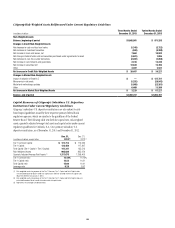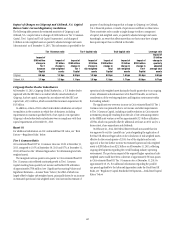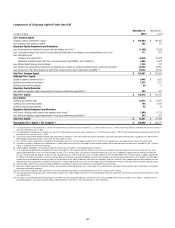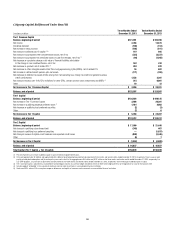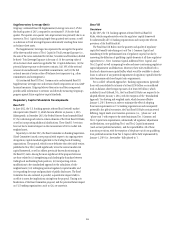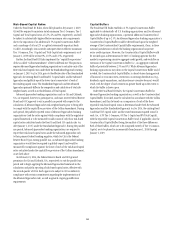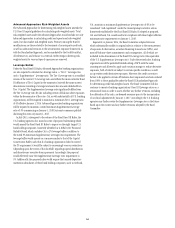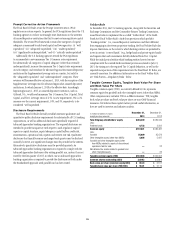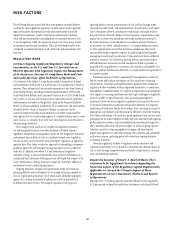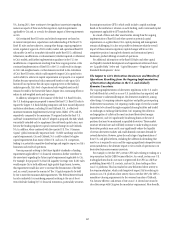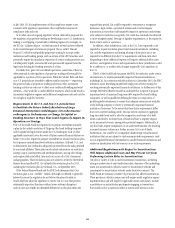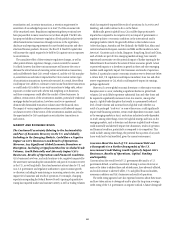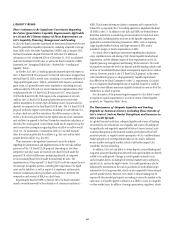Citibank 2013 Annual Report Download - page 74
Download and view the complete annual report
Please find page 74 of the 2013 Citibank annual report below. You can navigate through the pages in the report by either clicking on the pages listed below, or by using the keyword search tool below to find specific information within the annual report.56
RISK FACTORS
The following discussion sets forth what management currently believes
could be the most significant regulatory, market and economic, liquidity,
legal and business and operational risks and uncertainties that could
impact Citi’s businesses, results of operations and financial condition.
Other risk and uncertainties, including those not currently known to Citi
or its management, could also negatively impact Citi’s businesses, results
of operations and financial condition. Thus, the following should not be
considered a complete discussion of all of the risks and uncertainties Citi
may face.
REGULATORY RISKS
Citi Faces Ongoing Significant Regulatory Changes and
Uncertainties in the U.S. and Non-U.S. Jurisdictions in
Which It Operates That Negatively Impact the Management
of Its Businesses, Increase Its Compliance Risks and Costs
and Could Adversely Affect Its Results of Operations.
Citi continues to be subject to a significant number of regulatory changes
and uncertainties both in the U.S. and the non-U.S. jurisdictions in which it
operates. These changes and uncertainties emanate not only from financial
crisis related reforms, including continued implementation of The Dodd-
Frank Wall Street Reform and Consumer Protection Act of 2010 (Dodd-Frank
Act) in the U.S., but also reform proposals by national financial authorities
and international standard setting bodies (such as the Financial Stability
Board) as well as individual jurisdictions. The complexities and uncertainties
arising from the volume of regulatory changes or proposals, across
numerous regulatory bodies and jurisdictions, is further compounded by
what appears to be an accelerating urgency to complete reforms and, in some
cases, to do so in a manner that is the most advantageous or protectionist to
the proposing jurisdiction.
The complete scope and form of a number of regulatory initiatives
are still being finalized and, even when finalized, will likely require
significant interpretation and guidance. Moreover, the heightened regulatory
environment has resulted not only in a tendency toward more regulation,
but also in some cases toward the most prescriptive regulation as regulatory
agencies have often taken a restrictive approach to rulemaking, interpretive
guidance, approvals and their general ongoing supervisory or prudential
authority. In addition, even when U.S. and international regulatory
initiatives overlap, in many instances they have not been undertaken on a
coordinated basis and areas of divergence have developed with respect to the
scope, interpretation, timing, structure or approach, leading to additional,
inconsistent or even conflicting regulations.
Ongoing regulatory changes and uncertainties make Citi’s business
planning difficult and could require Citi to change its business models or
even its organizational structure, all of which could ultimately negatively
impact Citi’s strategy and results of operations as well as realization of
its deferred tax assets (DTAs). For example, regulators have proposed
applying limits to certain concentrations of risk, such as through single
counterparty credit limits, and implementation of such limits could require
Citi to restructure client or counterparty relationships and could result in
the potential loss of clients. Further, certain regulatory requirements could
require Citi to create new subsidiaries in foreign jurisdictions instead of
its current branches, create subsidiaries to conduct particular businesses
or operations (so-called “subsidiarization”), or impose additional capital
or other requirements on branches in certain jurisdictions. This could,
among other things, negatively impact Citi’s global capital and liquidity
management and overall cost structure. Unless and until there is sufficient
regulatory certainty, Citi’s business planning and/or proposed pricing for
affected businesses necessarily include assumptions based on possible or
proposed rules, requirements or outcomes, any of which could impede Citi’s
ability to conduct its businesses effectively or comply with final requirements
in a timely manner.
Business planning is further complicated by management’s continual
need to review and evaluate the impact on Citi’s businesses of ongoing
rule proposals, final rules and implementation guidance from numerous
regulatory bodies worldwide, within compressed timeframes. In some cases,
management’s implementation of a regulatory requirement and assessment
of its impact is occurring simultaneously with legal challenges or legislative
action to modify or repeal final rules, thus increasing management
uncertainty. Moreover, recent regulatory guidance has focused on the need
for financial institutions to perform increased due diligence and ongoing
monitoring of third party vendor relationships, thus increasing the scope of
management involvement and decreasing the efficiency otherwise resulting
from these relationships. Citi must also spend significant time and resources
managing the increased compliance risks and costs associated with ongoing
global regulatory reforms. Citi has established various financial targets for
2015, including efficiency and returns targets, as well as ongoing expense
reduction initiatives. Ongoing regulatory changes and uncertainties
require management to continually manage Citi’s expenses and potentially
reallocate resources, including potentially away from ongoing business
investment initiatives.
Given the significant number of regulatory reform initiatives and
continued uncertainty, it is not possible to determine the ultimate impact to
Citi’s overall strategy, competitiveness and results of operations or, in many
cases, its individual businesses.
Despite the Issuance of Final U.S. Basel III Rules, There
Continues to Be Significant Uncertainty Regarding the
Numerous Aspects of the Regulatory Capital Requirements
Applicable to Citi and the Ultimate Impact of These
Requirements on Citi’s Businesses, Products and Results
of Operations.
Although the U.S. banking agencies issued final Basel III rules applicable
to Citigroup and its depository institution subsidiaries, including Citibank,


